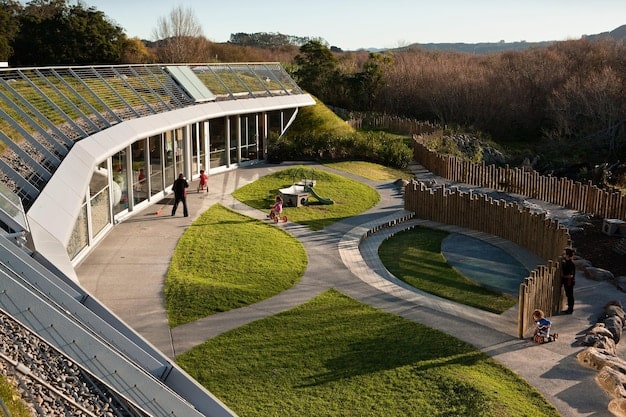Reduce Your Home’s Carbon Footprint: 5 Unexpected Ways for 2025

Reducing your home’s carbon footprint by 15% in 2025 can be achieved through implementing unexpected strategies such as optimizing your home’s lighting, smart water usage, harnessing waste heat, embracing eco-friendly landscaping, and utilizing smart home technology for energy efficiency.
Want to make a real difference for the planet without completely overhauling your lifestyle? Discover 5 Unexpected Ways to Reduce Your Home’s Carbon Footprint by 15% in 2025, offering practical and surprising approaches to shrink your environmental impact.
Optimize Your Home’s Lighting for Energy Efficiency
Lighting is essential, but it’s also a significant energy consumer. By making smart choices about your lighting, you can dramatically reduce your home’s carbon footprint. Let’s dive into how to brighten your home while also going green.
Switch to Smart Lighting Systems
Smart lighting systems offer unparalleled control over your home’s energy consumption. These systems often learn your habits and adjust lighting automatically.
Utilize Natural Light Maximization Strategies
Harnessing the power of natural light can significantly decrease your reliance on artificial lighting. Simple strategies can make a huge difference.
- Install light shelves to bounce sunlight deeper into rooms.
- Trim trees and shrubs that block sunlight from entering windows.
- Use light-colored paints and décor to reflect light throughout your home.

By optimizing your home’s lighting through smart technology and natural light strategies, you’ll not only reduce energy consumption but also enhance the ambiance of your living spaces. Making these improvements contributes to a more sustainable lifestyle.
Embrace Smart Water Usage Techniques
Water conservation is more than just a responsible practice; it’s a vital step in reducing your carbon footprint. The energy used to treat and deliver water contributes significantly to greenhouse gas emissions. Here’s how to use water more wisely.
Install Low-Flow Fixtures and Appliances
Upgrading to low-flow fixtures can significantly reduce water consumption without sacrificing performance. These upgrades are easy to install and provide immediate savings.
Implement Gray Water Recycling Systems
Gray water recycling systems reuse water from showers, sinks, and laundry for irrigation and toilet flushing. This reduces both water consumption and the associated energy costs.
- Ensure your system complies with local regulations and guidelines.
- Regularly maintain the system to prevent clogs and ensure proper functioning.
- Use appropriate filters and treatment methods to purify the gray water.
Adopting smart water usage techniques not only conserves a precious resource but also minimizes the energy required for water treatment and distribution. Embrace these techniques to lower your carbon footprint and promote environmental sustainability.
Harness Waste Heat for Energy Savings
Waste heat is a hidden source of energy that can be tapped into to reduce your carbon footprint. Capturing and reusing this heat can significantly decrease your reliance on traditional heating systems. Let’s explore how to make the most of this often-overlooked resource.
Install Heat Recovery Systems
Heat recovery systems capture waste heat from appliances and redirect it for useful purposes, such as preheating water or supplementing space heating.
Optimize Ventilation and Insulation
Proper ventilation and insulation help to retain heat within your home during winter and keep it out during summer. This reduces the need for excessive heating and cooling.
- Seal air leaks around windows, doors, and pipes.
- Upgrade insulation in attics, walls, and basements.
- Use energy-efficient windows and doors with low-E coatings.
By harnessing waste heat, you’re not only reducing your carbon footprint but also creating a more energy-efficient and comfortable home. These measures contribute to a sustainable lifestyle and can lead to significant savings on energy bills.
Embrace Eco-Friendly Landscaping Practices
Your yard can play a significant role in reducing your carbon footprint. Sustainable landscaping practices not only enhance your property’s beauty but also contribute to environmental conservation. Let’s see how to make your outdoor spaces eco-friendly.
Plant Native and Drought-Resistant Species
Native plants require less water, fertilizer, and pesticides than non-native species. They also support local ecosystems and biodiversity.
Create a Composting System
Composting food scraps and yard waste reduces landfill waste and creates nutrient-rich soil for your garden. This reduces the need for synthetic fertilizers.

- Use a compost bin or tumbler to collect organic waste.
- Turn the compost regularly to promote decomposition.
- Use the finished compost to enrich your garden soil.
Eco-friendly landscaping practices transform your yard into a carbon sink, reducing your environmental impact and promoting biodiversity. By implementing these strategies, you can create a sustainable outdoor space that benefits both your home and the environment.
Utilize Smart Home Technology for Energy Efficiency
Smart home technology offers innovative ways to monitor and control energy consumption. These devices provide real-time data and automated adjustments, ensuring optimal energy usage. Let’s explore the benefits of incorporating smart home technology into your energy-saving strategy.
Install Smart Thermostats and Sensors
Smart thermostats learn your heating and cooling preferences and adjust temperatures automatically. Sensors detect occupancy and adjust settings accordingly, preventing energy waste.
Monitor Energy Consumption with Smart Meters
Smart meters provide detailed data on your energy usage, allowing you to identify areas where you can reduce consumption. This data empowers you to make informed decisions about energy management.
- Review your energy usage data regularly.
- Identify patterns and areas of high consumption.
- Adjust your habits and appliance usage to reduce energy waste.
By leveraging smart home technology, you can gain unprecedented control over your energy consumption and reduce your carbon footprint. These devices make it easier to manage your energy usage and promote a sustainable lifestyle. Embracing these advancements can lead to substantial energy savings and a greener home.
Conduct an Energy Audit and Implement Recommendations
A comprehensive energy audit is a vital step in understanding your home’s energy performance. This audit identifies areas of energy waste and provides tailored recommendations for improvement. Let’s explore how to conduct an energy audit and implement its findings.
Hire a Professional Energy Auditor
Professional energy auditors use specialized equipment to assess your home’s energy efficiency. They identify air leaks, insulation deficiencies, and other sources of energy waste.
Implement Audit Recommendations
After the audit, prioritize and implement the recommended improvements. These may include sealing air leaks, upgrading insulation, and replacing inefficient appliances.
- Prioritize improvements based on cost-effectiveness and impact.
- Start with low-cost measures like sealing air leaks and replacing light bulbs.
- Plan for larger investments like insulation upgrades and appliance replacements.
By conducting an energy audit and implementing its recommendations, you can identify and address the root causes of energy waste in your home. This proactive approach leads to significant energy savings and a reduced carbon footprint, creating a more sustainable and efficient living environment.
| Key Point | Brief Description |
|---|---|
| 💡 Smart Lighting | Use smart systems and maximize natural light to reduce energy. |
| 💧 Water Efficiency | Install low-flow fixtures and grey water recycling systems. |
| 🔥 Waste Heat Harness | Capture heat from appliances and optimize insulation. |
| 🌳 Eco-Landscaping | Plant native species and compost waste for a green yard. |
FAQ
▼
Smart lighting systems use energy more efficiently by adjusting brightness based on occupancy and ambient light, reducing overall energy consumption and carbon emissions.
▼
Gray water recycling reduces the demand for freshwater, lowers water bills, and decreases the energy needed to treat and transport water, thus lessening your environmental impact.
▼
Harnessing waste heat recovers energy that would otherwise be lost, reducing the need for additional heating or cooling, which in turn lowers energy consumption and carbon emissions.
▼
Eco-friendly landscaping reduces water and chemical use, supports local biodiversity, and can even sequester carbon, making your yard a part of the solution to climate change.
▼
Smart home devices like thermostats and sensors automate energy usage based on your habits and real-time conditions, preventing energy waste and optimizing consumption for a lower carbon footprint.
Conclusion
By implementing these five unexpected strategies — optimizing lighting, embracing smart water usage, harnessing waste heat, adopting eco-friendly landscaping, and leveraging smart home technology — you can significantly reduce your home’s carbon footprint by 15% in 2025, contributing to a greener and more sustainable future.





